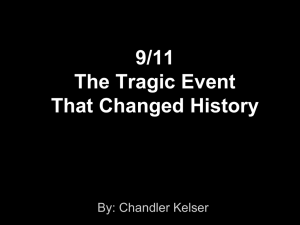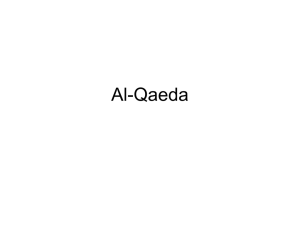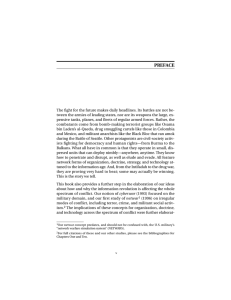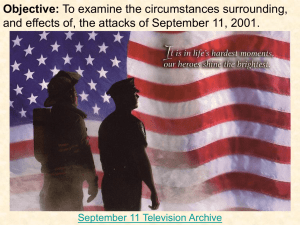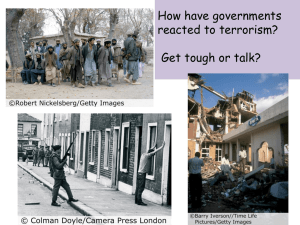AFTERWORD (SEPTEMBER 2001): THE SHARPENING FIGHT FOR THE FUTURE
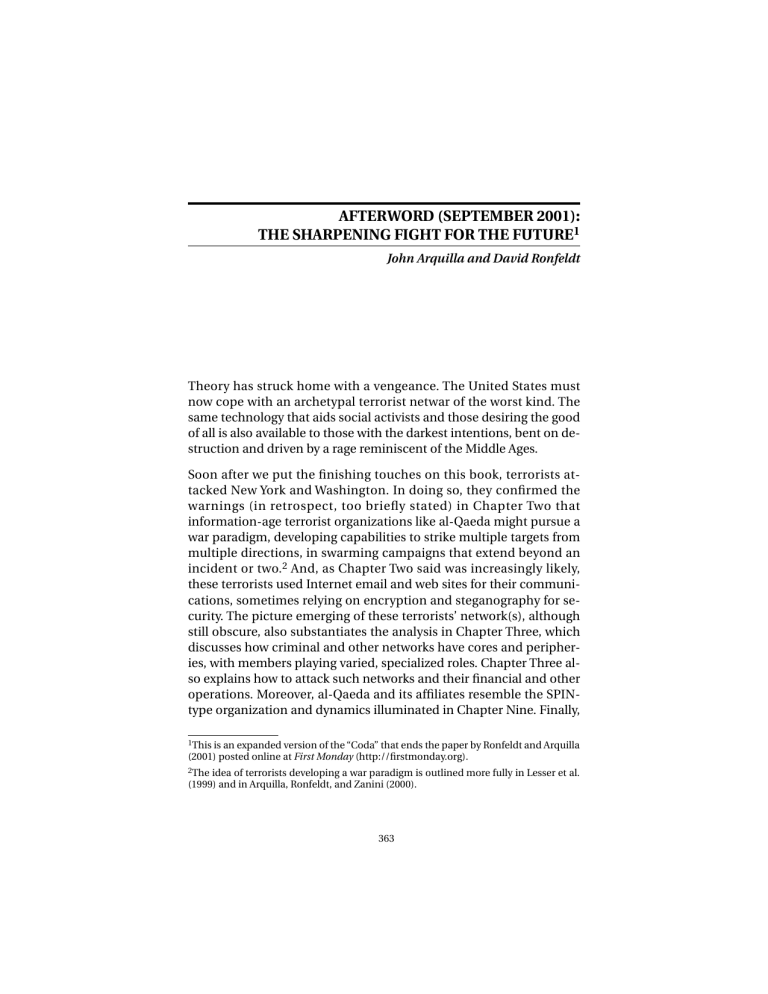
AFTERWORD (SEPTEMBER 2001):
THE SHARPENING FIGHT FOR THE FUTURE
1
John Arquilla and David Ronfeldt
Theory has struck home with a vengeance. The United States must now cope with an archetypal terrorist netwar of the worst kind. The same technology that aids social activists and those desiring the good of all is also available to those with the darkest intentions, bent on destruction and driven by a rage reminiscent of the Middle Ages.
Soon after we put the finishing touches on this book, terrorists attacked New York and Washington. In doing so, they confirmed the warnings (in retrospect, too briefly stated) in Chapter Two that information-age terrorist organizations like al-Qaeda might pursue a war paradigm, developing capabilities to strike multiple targets from multiple directions, in swarming campaigns that extend beyond an incident or two.
2 And, as Chapter Two said was increasingly likely, these terrorists used Internet email and web sites for their communications, sometimes relying on encryption and steganography for security. The picture emerging of these terrorists’ network(s), although still obscure, also substantiates the analysis in Chapter Three, which discusses how criminal and other networks have cores and peripheries, with members playing varied, specialized roles. Chapter Three also explains how to attack such networks and their financial and other operations. Moreover, al-Qaeda and its affiliates resemble the SPINtype organization and dynamics illuminated in Chapter Nine. Finally,
1 This is an expanded version of the “Coda” that ends the paper by Ronfeldt and Arquilla
(2001) posted online at First Monday (http://firstmonday.org).
2 The idea of terrorists developing a war paradigm is outlined more fully in Lesser et al.
(1999) and in Arquilla, Ronfeldt, and Zanini (2000).
363
364 Networks and Netwars: The Future of Terror, Crime, and Militancy in Los Angeles, the terrorist events had the effect of mobilizing the innovative Terrorist Early Warning Group discussed in Chapter Four.
3
This book is suddenly much more pertinent than we had expected.
4
If Osama bin Laden’s al-Qaeda network is the principal adversary—as seems likely, although other possibilities, including sponsorship by a rogue state like Iraq, cannot be discarded yet—then it may prove useful to view the network from the perspective of the five levels of theory and practice we elucidate in Chapter Ten (organizational, narrative, doctrinal, technological, and social).
5 First, at the organizational level, we see a major confrontation between hierarchical/state and networked/nonstate actors. For the United States and its friends and allies, one challenge will be to learn to network better with each other.
Some of this is already going on, in terms of intelligence sharing, but much more must be done to build a globally operational counterterror network. A particular challenge for the cumbersome American bureaucracy will be to encourage deep, all-channel networking among the military, law enforcement, and intelligence elements whose collaboration is crucial for achieving success. U.S. agencies have been headed in this direction for years—in the areas of counternarcotics as well as counterterrorism—but interagency rivalries and distrust have too often slowed progress.
Regarding al-Qaeda, the organizational challenge seems to lie in determining whether this network is a single hub designed around bin
Laden. If this is the case, then his death or capture would signal its defeat. However, the more a terrorist network takes the form of a multi-
3 We are grateful to Paul de Armond, author of Chapter Seven, for a September 12, 2001, email that spelled out the ways in which these terrorist attacks took advantage of netwar and swarming paradigms and noted that the U.S. response should include a skillful information strategy.
4 Meanwhile, the literature on other aspects continues to expand. Additions we like include Kalathil and Boas (2001), Kapstein (2001), Metzl (2001), and Tarrow (2001)—all of which bear, in one respect or another, on the prospects for improving cooperation between governments and nongovernmental organizations. Also see “Special Issue on
Mapping Globalization,” American Behavioral Scientist , Vol. 44, No. 10, June 2001, edited by Eszter Hargittai and Miguel Angel Centeno and supported by the International
Networks Archive (based at www.princeton.edu/~ina).
5 Joel Garreau, “Disconnect the Dots,” Washington Post , September 17, 2001, offers additional discussion, based on interviews with social network analysts, about how to attack a terrorist network.
Afterword (September 2001): The Sharpening Fight for the Future 365 hub “spider’s web” design, with multiple centers and peripheries, the more redundant and resilient it will be—and the harder to defeat.
6 In a somewhat analogous vein, it is worthwhile to note that since Napster’s activities were curtailed by legal action in the United States, more free music is being downloaded and shared by loose peer-topeer networks. Also, note that, despite the dismantling of the powerful Medellín and Cali cartels during the 1990s, drug smuggling by a plethora of small organizations continues to flourish in Colombia.
The risk is that small, more nimble networks may spring up as successors to a defeated large network.
Second, at the narrative level, there is the broad contention of Western liberal ideas about the spread of free markets, free peoples, and open societies versus Muslim convictions about the exploitative, invasive, demeaning nature of Western incursions into the Islamic world. To use Samuel Huntington’s phrase, this conflict involves a
“clash of civilizations.” Also, at the narrative level it might be deemed a “time war” (term from Rifkin, 1987), in that this terrorist mindset is, in a sense, so tribal, medieval, absolutist, and messianic that it represents an effort to challenge the 21st century with 16th century (and earlier) ideals—as well as to ruin Americans’ hopes about their future.
Indeed, it may be advisable for U.S. strategy to approach this conflict more as a time war than as a clash of civilizations. Bin Laden is an Arab Muslim, but that is not the only context in which to view him. He resembles, in many respects, some of the more fanatical figures out of
6 A study with inputs from various researchers, “Special Report: Al-Qaeda,” Jane’s Intelligence Review , August 2001, pp. 42–51, provides an extensive analysis of al-Qaeda’s organizational structure, history, and activities. The analysis views al-Qaeda as a kind of
“conglomerate,” with both formal vertical and informal horizontal elements, making it a partial hybrid of hierarchical and network forms of organization.
366 Networks and Netwars: The Future of Terror, Crime, and Militancy
Norman Cohn’s The Pursuit of the Millennium (1961) 7 and Eric Hoffer’s The True Believer (1951).
8 Bin Laden is not clinically “insane,” but he and his appeal are culturally and temporally perverse.
9
To this basic imagery, the United States has made a point of adding that these terrorist attacks were “acts of war” against not only America
7 Consider this statement from Cohn (1961, pp. 314–315) about messianic religious fanaticism, known as chiliasm, that coursed through Europe in the Middle Ages:
In the Middle Ages, the people for whom revolutionary Chiliasm had most appeal were neither peasants firmly integrated in the village and manor nor artisans firmly integrated in their guilds. The lot of such people might at times be one of poverty and oppression, and at other times be one of relative prosperity and independence; they might revolt or they might accept the situation; but they were not, on the whole, prone to follow some inspired propheta in a hectic pursuit of the Millennium. . . .
Revolutionary Chiliasm drew its strength from the surplus population living on the margin of society—peasants without land or with too little land even for subsistence; journeymen and unskilled workers living under the continuous threat of unemployment; beggars and vagabonds . . . .
These people lacked the material and emotional support afforded by traditional social groups; their kinship-groups had disintegrated and they were not effectively organized in village communities or in guilds; for them there existed no regular, institutionalized methods of voicing their grievances or pressing their claims. Instead, they waited for a propheta to bind them together in a group of their own—which would then emerge as a movement of a peculiar kind, driven on by a wild enthusiasm born of desperation.
8 Consider this statement by Hoffer (1951) (from a Harper Perennial edition of Hoffer’s book issued in 1989, pp. 11–12) about “true believers” who enter into radical mass movements:
For men to plunge headlong into an undertaking of vast change, they must be intensely discontented yet not destitute, and they must have the feeling that by the possession of some potent doctrine, infallible leader or some new technique they have access to a source of irresistible power.
They must have an extravagant conception of the prospects and potentialities of the future. Finally, they must be ignorant of the difficulties involved in their vast undertaking. . . .
On the one hand, a mass movement . . . appeals not to those intent on bolstering and advancing a cherished self, but to those who crave to be rid of an unwanted self. A mass movement attracts and holds a following not because it can satisfy the desire for self-advancement, but because it can satisfy the passion for self-renunciation.
9 A further comparison, drawn from Greek myth and tragedy, is that bin Laden aims to be the Nemesis of American hubris . This goddess of divine retribution is sent by Zeus to destroy mortals afflicted with this capital sin of pride, the pretension to be godlike.
However, bin Laden may yet reveal that he has a “hubris-nemesis complex.” For background, see Ronfeldt (1994).
Afterword (September 2001): The Sharpening Fight for the Future 367 but also against “the civilized world,” and American public opinion has been quickly galvanized by the revival of the Pearl Harbor metaphor. Indeed, the disproportionate nature of the terrorists’ use of force—including the mass murder of civilians—can only reinforce feelings of righteous indignation. Against this, the perpetrators are likely to exalt their own “holy war” imagery, which they will have trouble exploiting beyond the Islamic world—and they cannot do even that well as long as they remain concealed behind a veil of anonymity.
But while the United States may have the edge in the “battle of the story” in much of the world, it will have to think deeply about how to keep that edge if U.S. forces are sent into action in any Middle Eastern countries. The development of the new field of “information strategy” is needed more than ever (see Arquilla and Ronfeldt, 1999, including the notion of creating “special media forces”).
Third, in terms of doctrine, the al-Qaeda network seems to have a grasp of the nonlinear nature of the battlespace, and of the value of attack from multiple directions by dispersed small units. If this is indeed a war being waged by al-Qaeda, its first campaign was no doubt the bombing of the Khobar Towers in Saudi Arabia in 1996, followed by a sharp shift to Africa with the embassy bombings of 1998. In between, and since, there have been a number of other skirmishes in far-flung locales, with some smaller attacks succeeding, and others apparently having been prevented by good intelligence. Thus, bin
Laden and his cohorts appear to have developed a swarm-like doctrine that features a campaign of episodic, pulsing attacks by various nodes of his network—at locations sprawled across global time and space where he has advantages for seizing the initiative, stealthily.
10
Against this doctrine, the United States has seemingly little to pose, as yet. Some defensive efforts to increase “force protection” have been pursued, and missile strikes in Afghanistan and the Sudan in 1998 suggest that the offensive part of U.S. doctrine is based on aging notions of strategic bombardment. Needless to say, if our ideas about netwar, swarming, and the future of conflict are on the mark, the
10 For recent additions to the theoretical literature, see Johnson (2001) on “swarm logic,” and Bonabeau and Meyer (2001) on “swarm intelligence.” Swarming may benefit from advances in “peer-to-peer computing.” On this, see Oram (2001).
368 Networks and Netwars: The Future of Terror, Crime, and Militancy former is not likely to be a winning approach; a whole new doctrine based on small-unit swarming concepts should be developed. It is possible that the notion of “counterleadership targeting” will continue to be featured—this was tried against Moammar Qaddafi in 1986,
Saddam Hussein in 1991, Mohamed Aidid in 1993, and against bin
Laden himself in 1998. Every effort to date has failed, 11 but that may not keep the United States from trying yet again, as this seems a part of its doctrinal paradigm. Besides, if bin Laden is the only hub of the al-Qaeda network—possible, though unlikely—his death, capture, or extradition might turn the tide in this conflict.
Fourth, at the technological level, the United States possesses a vast array of very advanced systems, while al-Qaeda has relatively few— and has great and increasing reluctance to use advanced telecommunications because of the risks of detection and tracking. But this category cannot be analyzed quite so simply. The United States, for example, has extensive “national technical means” for gathering intelligence and targeting information—but perhaps only a small portion of these means have utility against dispersed, networked terrorists. Orbital assets—now the linchpins of American intelligence— may prove of little use against bin Laden. At the same time, al-Qaeda has access to commercial off-the-shelf technologies that may prove a boon to their operations.
Fifth, at the social level, this network features tight religious and kinship bonds among the terrorists, who share a tribal, clannish view of
“us” versus “them.” Al-Qaeda’s edge in this dimension ties into its narrative level, with Islam being the pivot between the story of “holy war” against “infidels” and the network’s ability to recruit and deploy hatefilled, death-bound strike forces who evince a singleness of mind and purpose. Against this, the United States faces a profound defensive challenge at the social level: How will the American people, despite the arousal of nationalism, react to the potential need to become a less open society in order to become more secure? If the Pearl Harbor metaphor—key to the American narrative dimension—holds up, and
11 The Russians succeeded in killing Dzhokhar Dudayev during the first (1994–1996)
Chechen War—apparently triangulating on him while he used a cell phone—but the networked Chechens did quite well in that war, even without their “leader.”
Afterword (September 2001): The Sharpening Fight for the Future 369 if U.S. operations result in successful early counterstrikes, then there may be unusual public solidarity to sustain the “war against terrorism” at the social level. But something of a social divide may emerge between the United States and Europe over whether the response to the attack on America should be guided by a “war” or a “law enforcement” paradigm.
In summary, a netwar perspective on the various dimensions of the struggle with al-Qaeda—again, if this is indeed the key adversary, or one of the them—renders some interesting insights into both the context and conduct of this first major conflict of the new millennium. At present, bin Laden and al-Qaeda seem to hold advantages at the social and doctrinal levels, and apparently in the organizational domain as well. The United States and its allies probably hold only marginal advantages at the narrative and technological levels. In terms of strategy, there appears to be less room for al-Qaeda to improve. However, its sound doctrinal and solid social underpinnings might be further enhanced—and a vulnerability removed—if it moved further away from being a hub network revolving around bin
Laden. Indeed, this may be an optimal strategy for al-Qaeda, since it is delimited from waging an open “battle of the story” at the narrative level, its one other apparent strategic option.
For the United States and its allies, there is much room for improvement—most of all at the organizational and doctrinal levels. Simply put, the West must start to build its own networks and must learn to swarm the enemy, in order to keep it on the run or pinned down until it can be destroyed. The United States and its allies must also seize the initiative—including by applying pressure on any states that harbor or sponsor terrorists. To be sure, the edge at the narrative level in the world at large must be maintained, but this should be achievable with an economy of effort. The crucial work needs to be done in developing an innovative concept of operations and building the right kinds of networks to carry off a swarming campaign against networked terrorists. Because, at its heart, netwar is far more about organization and doctrine than it is about technology. The outcomes of current and future netwars are bound to confirm this.
370 Networks and Netwars: The Future of Terror, Crime, and Militancy
BIBLIOGRAPHY
Arquilla, John, and David Ronfeldt, The Emergence of Noopolitik: Toward an American Information Strategy, Santa Monica, Calif.:
RAND, MR-1033-OSD, 1999.
Arquilla, John, David Ronfeldt, and Michele Zanini, “Information-Age
Terrorism,” Current History, Vol. 99, No. 636, April 2000, pp. 179–
185.
Bonabeau, Eric, and Christopher Meyer, “Swarm Intelligence,” Harvard Business Review, May 2001, pp. 107–114.
Cohn, Norman, The Pursuit of the Millennium: Revolutionary Messianism in Medieval and Reformation Europe and Its Bearing on
Modern Totalitarian Movements , New York: Harper Torch Books,
1961.
Hoffer, Eric, The True Believer: Thoughts on the Nature of Mass Movements , New York: Harper & Row, 1951.
Johnson, Steven, Emergence: The Connected Lives of Ants, Brains, Cities, and Software , New York: Scribner, 2001.
Kalathil, Shanthi, and Taylor C. Boas, “The Internet and State Control in Authoritarian Regimes: China, Cuba, and the Counterrevolution,” First Monday , August 2001, Vol. 6, No. 8, http://firstmonday.org/issues/issue6_8/kalathil/.
Kapstein, Ethan B., “The Corporate Ethics Crusade,” Foreign Affairs ,
Vol. 80, No. 5, September/October 2001, pp. 105–119.
Lesser, Ian O., Bruce Hoffman, John Arquilla, David Ronfeldt, Michele
Zanini, and Brian Jenkins, Countering the New Terrorism , Santa
Monica, Calif.: RAND, MR-989-AF, 1999.
Metzl, Jamie F., “Network Diplomacy,” Georgetown Journal of International Affairs , Winter/Spring 2001, p. 796.
Oram, Andy, ed., Peer-to-Peer: Harnessing the Power of Disruptive
Technologies , O’Reilly & Associates, 2001.
Rifkin, Jeremy, Time Wars: The Primary Conflict in Human History ,
New York: Simon & Schuster, 1987.
Afterword (September 2001): The Sharpening Fight for the Future 371
Ronfeldt, David, The Hubris-Nemesis Complex: A Concept for Leadership Analysis , Santa Monica, Calif.: RAND, MR-461, 1994.
Ronfeldt, David, and John Arquilla, “Networks, Netwars, and the Fight for the Future,” First Monday , October 2001, Vol. 6, No. 10, http:// firstmonday.org/issue6_10/index.html.
Tarrow, Sidney, “Transnational Politics: Contention and Institutions in International Politics,” Annual Review of Political Science , Vol. 4,
2001, pp. 1–20.
